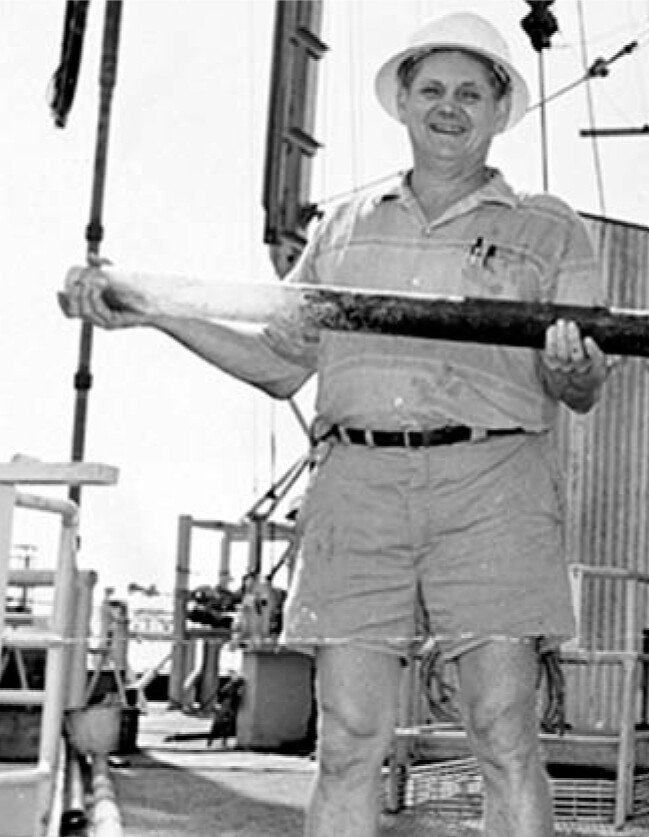John Lamar Worzel
DOI: 10.1063/1.3248494
John Lamar Worzel, who made groundbreaking contributions to the field of marine geophysics, died of a heart attack at home in Wilmington, North Carolina, on 26 December 2008. Joe, as he preferred to be called, developed his expertise in the years before the US entered World War II; he was at the right place at the right time, when the field was in its infancy.
Joe was born on 21 February 1919 in Staten Island, New York. As a child, he contracted numerous diseases, broke limbs, and suffered heart damage from rheumatic fever. Those afflictions, he said, made him tougher and more resolved to compete well at everything.
When Joe arrived at Lehigh University in 1936, he welcomed the opportunity to work with physics professor Maurice Ewing and with other students, including Alan Vine, who developed the Alvin submersible. In the summer of 1940, following Joe’s graduation from Lehigh, Ewing took Joe and other students to Woods Hole Oceanographic Institution (WHOI). From scratch they built ocean-bottom seismographs to record the energy propagated through the crust. After many unsuccessful trials, their seismographs were successfully used to determine the thicknesses of the marine sediments and, eventually, of the oceanic and continental crusts, which were shown to be dramatically different from each other.
During their tenure at WHOI, Joe and his colleagues demonstrated the existence of low-velocity sound channels in the ocean, which allow small-amplitude acoustic signals to propagate thousands of kilometers. Those experiments were eventually used to locate, identify, and track ships and submarines.
By 1946 Ewing moved on to Columbia University in New York, and Joe went there too, to do his graduate work. In 1948 the university designated a gift from the Thomas Lamont estate to establish the Lamont Geological Observatory. Ewing was named its first director, and Joe its deputy. Joe simultaneously wore many hats at Lamont—among them science administrator, a role now shared by five people. For roughly 25 years, he and his family lived in a modest house on the Lamont campus and were an integral part of establishing and maintaining the “Lamont family.” Joe was the de facto welcomer to a steady stream of visiting scientists, many of whom recall his kindness, and he frequently invited students and colleagues into his home.
Colleagues recognized Joe’s gift for making things work. He loved getting his hands on a problem. He often preempted a frazzled technician by quickly fixing what the tech had been unable to and cheerfully remarking, “This electronics is a snap.”
One of Joe’s most important contributions, in the early to mid-1960s, relates to the measurement of gravity at sea. Initially, gravity measurements were made only aboard submarines and were notoriously cumbersome and time consuming; measuring gravity aboard a surface vessel presented a different and greater challenge because a ship rolls and pitches and typically experiences large accelerations indistinguishable from small changes in Earth’s gravity field. Joe made significant improvements in perfecting the measurement process.
To solve the problem of measuring the small spatial variations of Earth’s gravity field, Joe mounted a hybrid gravimeter onto a gyro-stabilized table; by applying suitable filtering, he demonstrated that even on a surface vessel one could measure the small differences in gravity to a few milligals (1 mgal = 10-3 cm/s2). That breakthrough was a vast improvement over the previous restricted use of submarines. The data were used to study the sea floor’s large tectonic features, such as deep-sea trenches and continental margins.
Joe was also interested in obtaining high-resolution seismic images of the layers tens of meters beneath the sea floor. He was instrumental in creating the tools needed to produce those and deeper-penetrating images. The tools led to subsequent mapping and piston-core sampling of many sub-sea-floor features, such as the Worzel white ash layer, which shows evidence of a major terrestrial volcanic eruption.
In 1963 the USS Thresher, a US Navy submarine, lost communications and was presumed to have sunk. Led in large part by Joe, a small group of academics and navy personnel searched for and eventually verified fragments of the submarine’s structure on the sea floor 8400 meters below the surface. For his role in the search, Joe received a Meritorious Service Award from the navy.
Student protests at Columbia in 1968 led the university to ban classified underwater research, which the Lamont observatory had been engaged in since its inception. Lamont’s highly successful sonar research programs, based in Bermuda, seemed destined to end. From necessity, Joe and several colleagues created the Palisades Geophysical Institute, a not-for-profit corporation that had no restrictions on conducting classified navy-sponsored research. Over nearly 40 years, with Joe as president for many of them, PGI also generously bestowed on Lamont and other worthy geoscience institutions several large gifts. PGI closed shop in 2002.
In 1972, dissatisfied with Columbia’s level of support, Joe and Ewing went to the University of Texas to establish a new geophysical research institute. Ewing died two years later, and Joe inherited the institute’s management and fiscal responsibilities. He devoted much of his energy to establishing a towed multichannel seismic capability. In 1979 he retired and became an enthusiastic golfer.
Joe at times was brusque, but he was also most kind and generous. He liked to spar with people about science and about life. He showed many of us that doing marine geophysics was not only exciting and timely but usually a lot of fun.

John Lamar Worzel
LAMONT-DOHERTY EARTH OBSERVATORY

More about the Authors
Dennis E. Hayes. Columbia University, New York City, US .
